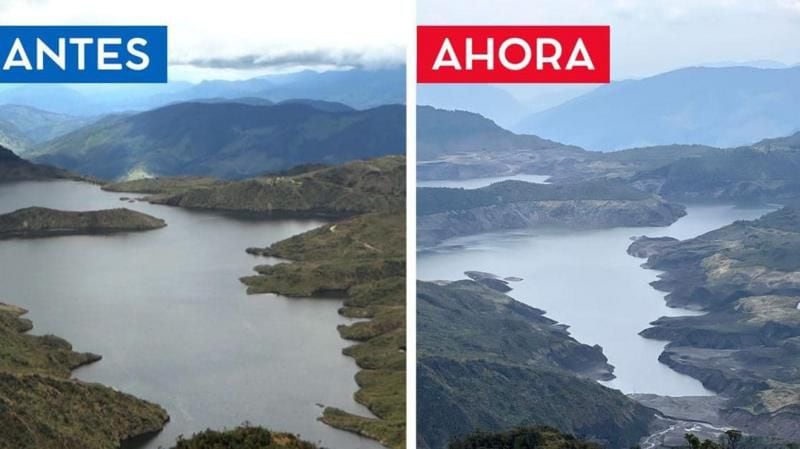This Thursday, 11 Bogotá started an indefinite water rationing plan with which it intends to face the serious drought it has been suffering since mid-2023.
TO LOOK: Why is Israel on high alert and what does Iran have to do with it?
To implement this rationing, the capital’s municipality divided the city into 9 zones and each of them will see water service suspended for 24 hours before moving on to the next.
Furthermore, every 15 days, authorities will evaluate the effectiveness of rationing.
With this measure, the Bogotá government hopes to save 2 cubic meters of water per second until reaching at least 20.3% of capacity in the Chingaza system reservoirs by the end of the month.
Chingaza is made up of two reservoirs that supply 70% of Bogotá and is currently at 16.32% of its capacity due to the drought of the last 10 months in the region, caused by the El Niño phenomenon, especially accentuated by a month of March in which almost no there was rain.
This measure, say Colombian authorities, affects at least 7 of Bogotá’s almost 11 million inhabitants. However, the urgency of making the decision is evident just by looking at the images that compare the state of the reservoirs before the drought and currently.

But this crisis is not only a product of climate change, but also of irresponsible water consumption by citizens. As the manager of the Bogotá aqueduct, Natasha Avendaño, explains to the BBC, average consumption per cubic meter has increased compared to the previous year.
The mayor of Bogotá, Carlos Fernando Galán, assured that the capital’s water system is at the lowest level since it began operations in the 1980s.
Given this, the mayor made some recommendations that provoked diverse reactions among the population and quickly went viral on social media. “At the weekend, if you’re not going out, don’t take a shower.”, said Galán on national television.
On Friday, the 12th, the municipality described as “good, but still insufficient” the results of the first day of restrictions in which a consumption of 15.8 cubic meters per second was recorded, when the target is 15.
The effects of El Niño in Bogotá and the risk of the damage spreading to other regions led the Colombian government to create a Unified Command Post, PMU, composed of the ministries of Environment, Mines and Energy and the National Risk Management Unit . .
“We need to make a strong appeal at national level to save water and energy. We are not in a scenario of imminent risk of shortages, but we must be attentive and alert“, warned the Minister of the Environment, Susana Muhamad.
The Institute of Hydrology, Meteorology and Environmental Studies (Ideam), in turn, gave hope to the population by announcing that during the next two months El Niño would weaken and give way to the arrival of the La Niña phenomenon, which would predict a cold quarter for June, July and August.
The transition would cause an increase of between 10% and 30% in rainfall in the country, according to Ideam.
Furthermore, the director of the District Institute for Risk Management and Climate Change (Idiger), Guillermo Escobar, announced that “above normal” rainfall is expected during May in Bogotá.
Entry of moisture into the country. Rain and thunderstorms for the next few hours are expected in Santander, Boyacá, west of Antioquia, Risaralda, Cauca, Valle del Cauca, Chocó, Guaviare, Caquetá, Putumayo, Vaupes, Casanare, Meta, Vichada, Cundinamarca and Tolima. pic.twitter.com/8WwbZF3bpD
— Ideam Colombia (@IDEAMColombia) April 2, 2024
Source: Elcomercio
I am Jack Morton and I work in 24 News Recorder. I mostly cover world news and I have also authored 24 news recorder. I find this work highly interesting and it allows me to keep up with current events happening around the world.

:quality(75)/cloudfront-us-east-1.images.arcpublishing.com/elcomercio/NJLSLUACIJDBVGT4CRHPDMANKQ.jpeg)

:quality(75)/cloudfront-us-east-1.images.arcpublishing.com/elcomercio/F7Y5SW6MBJBIBLWGQXSX7GB44E.jpg)
:quality(75)/cloudfront-us-east-1.images.arcpublishing.com/elcomercio/ZXOXY4KSYNGBNBQWH2WDGTN7RM.jpg)
:quality(75)/cloudfront-us-east-1.images.arcpublishing.com/elcomercio/6Y64F4RRIVGX7JNHV6O23KVL7E.jpg)

